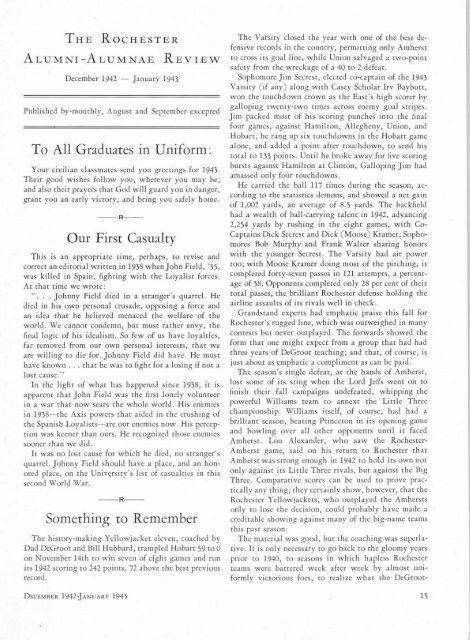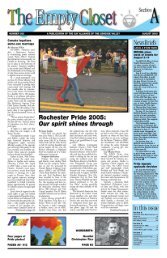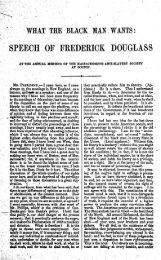Download PDF - University of Rochester Libraries
Download PDF - University of Rochester Libraries
Download PDF - University of Rochester Libraries
Create successful ePaper yourself
Turn your PDF publications into a flip-book with our unique Google optimized e-Paper software.
ALUM<br />
THE<br />
ROCHESTER<br />
I-ALUMNAE REVIEW<br />
December 1942 - January 1943<br />
Published by-monthly, August and September excepted<br />
To All Graduates in Uniform:<br />
Your civilian classmates send you greetings for 1943.<br />
Their good wishes follow you, wherever you may be;<br />
and also their prayers that God will guard you in danger,<br />
grant you an early victory, and bring you safely home.<br />
--R--<br />
Our First Casualty<br />
This is an appropriate time, perhaps, to revise and<br />
correct an editorial written in 1938 whenJohn Field, '35,<br />
was killed in Spain, fighting with the Loyalist forces.<br />
At that time we wrote:<br />
"... Johnny Field died in a stranger's quarrel. He<br />
died in his own personal crusade, opposing a force and<br />
an idea that he believed menaced the welfare <strong>of</strong> the<br />
world. We cannot condemn, but must rather envy, the<br />
final logic <strong>of</strong> his idealism. So few <strong>of</strong> us have loyalties,<br />
far removed from our own personal interests, that we<br />
are willing to die for. Johnny Field did have. He must<br />
have known ... that he was to fight for a losing if not a<br />
lost cause."<br />
In the light <strong>of</strong> what has happened since 1938, it is<br />
apparent that John Field was the first lonely volunteer<br />
in a war that now sears the whole world. His enemies<br />
in 1938-the Axis powers that aided in the crushing <strong>of</strong><br />
the Spanish Loyalists-are our enemies now. His perception<br />
was keener than ours. He recognized those enemies<br />
sooner than we did.<br />
It was no lost cause for which he died, no stranger's<br />
quarrel. Johnny Field should have a place, and an honored<br />
place, on the <strong>University</strong>'s list <strong>of</strong> casualties in this<br />
second World War.<br />
--R--<br />
Something to Remember<br />
The history-making Yellowjacket eleven, coached by<br />
Dud DeGroot and Bill Hubbard, trampled Hobart 59 to 0<br />
on November 14th to win seven <strong>of</strong> eight games and run<br />
its 1942 scoring to 242 points, 72 above the best previous<br />
record.<br />
The Varsity closed the year with one <strong>of</strong> the best defensive<br />
records in the country, permitting only Amherst<br />
to cross its goal line, while Union salvaged a two-point<br />
safety from the wreckage <strong>of</strong> a 40 to 2 defeat.<br />
Sophomore Jim Secrest, elected co-captain <strong>of</strong> the 1943<br />
Varsity (if any) along with Casey Scholar Irv Baybutt,<br />
won the touchdown crown as the East's high scorer by<br />
galloping twenty-two times across enemy goal stripes.<br />
Jim packed most <strong>of</strong> his scoring punches into the final<br />
four games, against Hamilton, Allegheny, Union, and<br />
Hobart; he rang up six touchdowns in the Hobart game<br />
alone, and added a point after touchdown, to send his<br />
total to 133 points. Until he broke away for five scoring<br />
bursts against Hamilton at Clinton, Galloping Jim had<br />
amassed only four touchdowns.<br />
He carried the ball 117 times during the season, according<br />
to the statistics demons, and showed a net gain<br />
<strong>of</strong> 1,002 yards, an average <strong>of</strong> 8.5 yards. The backfield<br />
had a wealth <strong>of</strong> ball-carrying talent in 1942, advancing<br />
2,254 yards by rushing in the eight games, with Co<br />
Captains Dick Secrest and Dick (Moose) Kramer; Sophomores<br />
Bob Murphy and Frank Walter sharing honors<br />
with the younger Secrest. The Varsity had air power<br />
too; with Moose Kramer doing most <strong>of</strong> the pitching, it<br />
completed forty-seven passes in 121 attempts, a percentage<br />
<strong>of</strong> 38. Opponents completed only 28 per cent <strong>of</strong> their<br />
total passes, the brilliant <strong>Rochester</strong> defense holding the<br />
airline assaults <strong>of</strong> its rivals well in check.<br />
Grandstand experts had emphatic praise this fall for<br />
<strong>Rochester</strong>'s rugged line, which was outweighed in many<br />
contests but never outplayed. The forwards showed the<br />
form that one might expect from a group that had had<br />
three years <strong>of</strong> DeGroot teaching; and that, <strong>of</strong> course, is<br />
just about as emphatic a compliment as can be paid.<br />
The season's single defeat, at the hands <strong>of</strong> Amherst,<br />
lost some <strong>of</strong> its sting when the Lord Jeffs went on to<br />
finish their fall campaigns undefeated, whipping the<br />
powerful Williams team to annext the Little Three<br />
championship. Williams itself, <strong>of</strong> course, had had a<br />
1;>rilliant season, beating Princeton in its opening game<br />
and bowling over all other opponents until it faced<br />
Amherst. Lou Alexander, who saw the <strong>Rochester</strong><br />
Amherst game, said on his return to <strong>Rochester</strong> that<br />
Amherst was strong enough in 1942 to hold its own not<br />
only against its Little Three rivals, but against the Big<br />
Three. Comparative scores can be used to prove practically<br />
any thing; they certainly show, however, that the<br />
<strong>Rochester</strong> Yellowjackets, who outplayed the Amhersts<br />
only to lose the decision, could probably have made a<br />
creditable showing against many <strong>of</strong> the big-name teams<br />
this past season.<br />
The material was good, but the coaching was superlative.<br />
It is only necessary to go back to the gloomy years<br />
prior to 1940, to seasons in which hapless <strong>Rochester</strong><br />
teams were battered week after week by almost uniformly<br />
victorious foes, to realize what the DeGroot-<br />
DECEMBER 1942-JANUARY 1943 IS
















